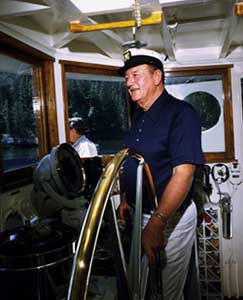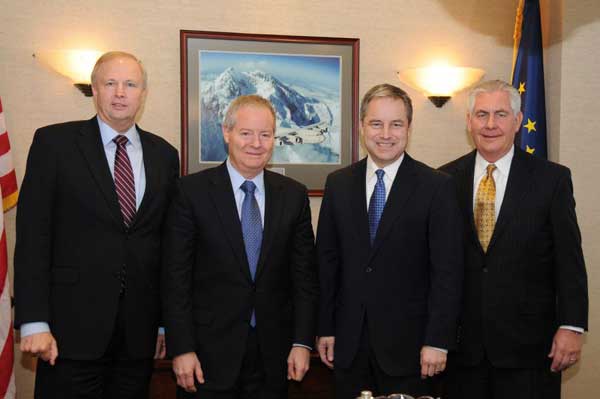The International Pacific Halibut Commission has recommended a Canadian harvest quota for the 2012 season of 7.038 million pounds of halibut, a decrease of eight per cent from the 2011 quota of 7.650 million pounds.
The Department of Fisheries and Oceans has yet to confirm the quota but it routinely follows the IPHC recommendation.
The reduction was not as bad as first feared. The commission staff were recommending a B.C coast quota of 6.633 million pounds, a decrease of 16 per cent.
The overall harvest quota decrease for the Pacific coast is 18.3 per cent, due to continuing concerns about the state of the halibut biomass.
The 2012 halibut season is much narrower, opening on March 17 and closing on November 7. The commission says the March 17 opening day was chosen because it is a Saturday and will help the marketing by both commercial and recreational fishers. The earlier November date will allow better assessment of the halibut stock after the 2012 season, according to an IPHC news release. (In Canada, DFO closed the recreational season much earlier than the date recommended by the IPHC, in September, while allowing the commercial harvest to continue.)
In the release following the annual meeting in Anchorage, Alaska, last week, the IPHC said
The Commission has expressed concern over continued declining catch rates in several areas and has taken aggressive action to reduce harvests. In addition, the staff has noted a continuing problem of reductions in previous estimates of biomass as additional data are obtained, which has the effect of increasing the realized historical harvest rates on the stock. Commission scientists will be conducting additional research on this matter in 2012….
The Commission faced very difficult decisions on the appropriate harvest from the stock and recognized the economic impact of the reduced catch limits recommended by its scientific staff. However, the Commission believes that conservation of the halibut resource is the most important management objective and will serve the best economic interests of the industry over the long term. Accordingly, catch limits adopted for 2012 were lower in all regions of the stock except Areas 2A (California, Oregon and Washington) and 2C (southeastern Alaska)
Pollock trawl bycatch crisis costs Canada $7 million a year
In the bureaucratic language of the IPHC, “The Commission expressed its continued concern about the yield and spawning biomass losses to the halibut stock from mortality of halibut in non-directed fisheries.”
The IPHC says that British Columbia has made “significant progress” in reducing bycatch mortality and that quotas for vessels for other fish are being monitored, in California, Oregon and Washington have also had some success in reducing bycatch mortality.
It says that “Reductions have also occurred in Alaska, and new measures aimed at improving bycatch estimation, scheduled to begin in 2013, will help to refine these estimates.”
That phrase apparently masks a major problem of bycatch in the halibut nurseries off Alaska.
Craig Medred writing in the Alaska Dispatch in Should Alaska have protected halibut nursery waters noted that the Canadian delegation took a strong stand at the meetings:
Canada has protested that something needs to be done about the trawl industry [mostly for pollock] killing and dumping 10 million pounds of halibut off Alaska’s coast, but the International Pacific Halibut Commission proved powerless to do anything about it.
Meeting [last] week in Anchorage, the commission recognized the trawl catch as a potential problem, but then placed the burden of conservation squarely on the shoulders of commercial longliners along the Pacific Coast from Alaska south to California. The Commission again endorsed staff recommendations to shrink the catches of those fishermen in an effort to avoid an ever-shrinking population of adult halibut.
(This wasn’t reported in the Canadian media despite the importance of halibut both commercial and recreational to the economy of British Columbia. No Canadian media covered the IPHC conference in Alaska, despite the fact that halibut was a major issue in BC in the last federal election)
Medred’s report in the Alaska Dispatch goes on to say that the scientists say the Pacific Ocean is full of juvenile halibut, but that the juveniles seem to be disappearing before they reach spawning age (when the halibut reaches about the 32 inch catch minimum). “How much of this is due to immature fish being caught, killed and wasted by the billion-dollar pollock trawl fishery — which is in essence strip mining the Gulf of Alaska — is unknown.”
Medred says, “Scientists, commercial halibut fishermen and anglers all believe the catch is under-reported. Advisers to the commission — a U.S.-Canada treaty organization — indicated they are beyond frustrated with the bycatch issue.”
The official IPHC Bluebook report to the annual meeting said: “Not all fisheries are observed, therefore bycatch rates and discard mortality rates from similar fisheries are used to calculate bycatch mortality in unobserved fisheries.”
The official report to the IPHC gives one reason that the bycatch in Canadian waters is not as big a problem, the Department of Fisheries and Oceans ongoing monitoring of almost all commercial fisheries for bycatch.
But Canada is not satisfied with that and has submitted a formal proposal to the Commission to designate the Gulf of Alaska, “‘an area of special concern.” because the halibut that spawn in the Gulf of Alaska migrate to coastal British Columbia.
The Alaska Dispatch report says that the Canadian delegation told the IPHC: “Canada should not and must not be penalized for uncontrolled bycatch in other regulatory (areas), which IPHC staff have indicated could be costing (Canada) approximately 1 million pounds of lost yield in each year based on current, and what Canada believes may be questionable, estimates of bycatch.”
Medred says that one million pounds of halibut equals a loss of $7 million to Canadian fishermen alone.




